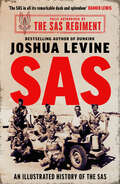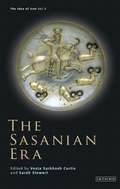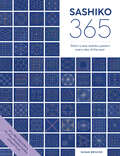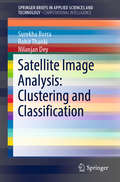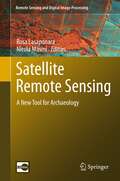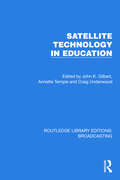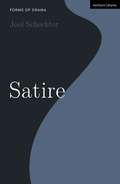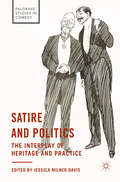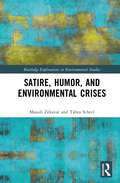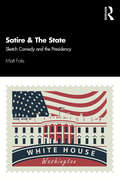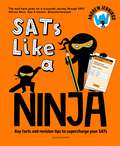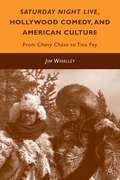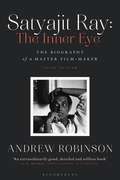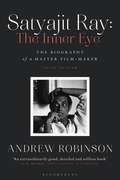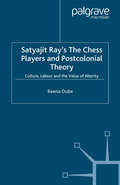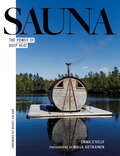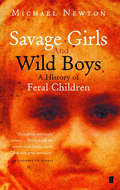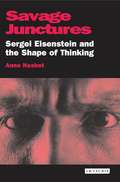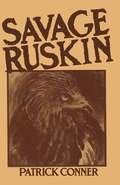- Table View
- List View
SAS: The Illustrated History Of The Sas
by Joshua LevineThe authorised illustrated history of the SAS by the number one bestselling author of Dunkirk, Joshua Levine. With never-before-seen photographs and unheard stories, this is the SAS’s wartime history in vivid and astonishing detail.
The Sasanian Era
by Vesta Sarkhosh Curtis Sarah StewartThis latest volume in "The Idea of Iran" series concentrates on the Sasanian period. Seizing power from the previous dynasty - the Parthians - the Sasanians ruled Iran and most of the ancient Near East from 224 until 642 CE. They are particularly fascinating because of their adherence to Zoroastrianism, an ancient dualistic Iranian religion named after the prophet Zarathustra (or, in Greek, Zoroaster). The Sasanians expressed the divine aspect of their rule in a variety of forms, such as on coins, rock reliefs and silver plates, and architecture and the arts flourished under their aegis. Sasanian military success brought them into conflict with Rome, and later Byzantium. Their empire eventually collapsed under the force of the Arab army in AD 642, when Zoroastrianism was replaced with Islam.Engaging with all the major aspects of Sasanian culture, twelve eminent scholars address subjects which include: early Sasanian art and iconography; early Sasanian coinage; religion and identity in the Sasanian empire; later Sasanian orality and literacy; and state and society in late antique Iran.The volume in question arguably comprises the most complete and comprehensive treatment of the Sasanian civilization yet to be published in English.
Sashiko 365: Stitch a new sashiko embroidery pattern every day of the year
by Susan BriscoeA collection of 365 different sashiko patterns to sew - one for every day of the year. Sashiko sewing expert, Susan Briscoe, demonstrates 365 different sashiko patterns, one for each day of the year - sew all 365 to make a beautiful sashiko quilt featuring all the designs Each sashiko pattern is stitched onto a four-inch square piece of fabric making it very accessible to sew one swatch every day. You can record the date of each sample you stitch in the book to create a record of your sewing. All of the stitch patterns are illustrated with a photograph of the stitched sample showing some stitches in different coloured thread (this is used by the author to identify which stitches to do first), next to a diagram showing the stitch direction and the order of the stitches on the grid. All the patterns are sewn on four-inch fabric swatches which can then be pieced together to create the ultimate double bed sized sashiko sampler quilt. But as well as sewing the four-inch samples separately to make them into a large bed-sized quilt, the patterns can also be repeated to create larger designs over a wider surface area to make wall hangings, throws, table mats and smaller quilts - with this collection of 365 designs the possibilities are endless. Sashiko embroidery is a decorative sewing technique from Japan which was traditionally used to reinforce clothing and other textiles. It is an ideal stitch for visible mending and has become incredibly popular over the last few years. The technique of sewing horizontal and vertical stitches makes extremely attractive geometric designs that can be adapted to suit a wide range of sewing projects. Susan Briscoe is an expert in Japanese sewing techniques and has travelled to Japan numerous times. She is the author of the best-selling Ultimate Sashiko Sourcebook and runs regular workshops teaching sashiko sewing. This is the first time all of these 365 designs will appear in one book. Susan has included the Japanese name and pattern type in the text and has grouped specific design patterns together so you can see how they develop and use the collection to build your skills and knowledge of sashiko patterns.
Satellite Image Analysis: Clustering and Classification (SpringerBriefs in Applied Sciences and Technology)
by Surekha Borra Rohit Thanki Nilanjan DeyThanks to recent advances in sensors, communication and satellite technology, data storage, processing and networking capabilities, satellite image acquisition and mining are now on the rise. In turn, satellite images play a vital role in providing essential geographical information. Highly accurate automatic classification and decision support systems can facilitate the efforts of data analysts, reduce human error, and allow the rapid and rigorous analysis of land use and land cover information. Integrating Machine Learning (ML) technology with the human visual psychometric can help meet geologists’ demands for more efficient and higher-quality classification in real time. This book introduces readers to key concepts, methods and models for satellite image analysis; highlights state-of-the-art classification and clustering techniques; discusses recent developments and remaining challenges; and addresses various applications, making it a valuable asset for engineers, data analysts and researchers in the fields of geographic information systems and remote sensing engineering.
Satellite Remote Sensing: A New Tool for Archaeology (Remote Sensing and Digital Image Processing #16)
by Rosa Lasaponara and Nicola MasiniThis book provides a state-of-the art overview of satellite archaeology and it is an invaluable volume for archaeologists, scientists, and managers interested in using satellite Earth Observation (EO) to improve the traditional approach for archaeological investigation, protection and management of Cultural Heritage. The recent increasing development of EO techniques and the tremendous advances in Information and Communication Technologies (ICT) have resulted primarily in Cultural Heritage applications. The book focuses on new challenging prospects for the use of EO in archaeology not only for probing the subsurface to unveil sites and artifacts, but also for the management and valorization as well as for the monitoring and preservation of cultural resources. The book provides a first-class understanding of this revolutionary scenario which was unthinkable several years ago. The book offers: (i) an excellent collection of outstanding articles focusing on satellite data processing, analysis and interpretation for archaeological applications, (ii) impressive case studies, (iii) striking examples of the high potential of the integration of multi-temporal, multi-scale, multi-sensors techniques. Each chapter is composed as an authoritative contribution to help the reader grasp the value of its content. The authors are renowned experts from the international scientific community. Audience: This book will be of interest to scientists in remote sensing applied to archeology, geoarcheology, paleo-environment, paleo-climate and cultural heritage.
Satellite Technology in Education (Routledge Library Editions: Broadcasting #31)
by John K. Gilbert Annette Temple Craig UnderwoodSatellite Technology in Education (1991) provides a coherent introduction to the potential of satellite technology in education. It begins with a brief technical history of some of the different systems, making distinctions between remote sensing, telecommunications and amateur radio satellites. It then examines the uses of satellite technology in the teaching of geography and environmental studies, languages, science and information technology. The book goes on to look at the response of different sectors, including schools and teacher education and higher education establishments, and concludes with a discussion of legal issues and an analysis of the resources needed to realize the impact of satellites on education.
Satellite Technology in Education (Routledge Library Editions: Broadcasting #31)
Satellite Technology in Education (1991) provides a coherent introduction to the potential of satellite technology in education. It begins with a brief technical history of some of the different systems, making distinctions between remote sensing, telecommunications and amateur radio satellites. It then examines the uses of satellite technology in the teaching of geography and environmental studies, languages, science and information technology. The book goes on to look at the response of different sectors, including schools and teacher education and higher education establishments, and concludes with a discussion of legal issues and an analysis of the resources needed to realize the impact of satellites on education.
Satire (Forms of Drama)
by Joel SchechterSatire reconsiders the entertainment, political dissent and comic social commentary created by innovative writers and directors since this theatrical form took the stage in ancient Athens. From Aristophanes to the 18th-century plays of John Gay and Henry Fielding, to the creations of Joan Littlewood, Bertolt Brecht, Vsevolod Meyerhold, Erika Mann, Brendan Behan and Dario Fo, practitioners of theatrical satire have prompted audiences to laugh at corruption, greed, injustice and abusive authority.In the theatre these artists jested at prominent citizens, scandals and fashions. In retrospect it can be seen that their topical references, allegories and impersonations also promoted intervention in public discourse and events outside the theatre, as satire extended its reach beyond the stage into society.Satire focuses on three exemplary satiric plays: The Knights by Aristophanes, The Beggar's Opera by John Gay and The Hostage by Brendan Behan under Joan Littlewood's direction. Detailed discussion of these three innovative works reveals both changes and continuities in stage satire over the course of its long, hilarious history. The survey concludes with a discussion of stage satire as an endangered art in need of preservation by actors, directors and theatre historians.
Satire: Theatrical Satire In The Age Of Walpole (Forms of Drama)
by Joel SchechterSatire reconsiders the entertainment, political dissent and comic social commentary created by innovative writers and directors since this theatrical form took the stage in ancient Athens. From Aristophanes to the 18th-century plays of John Gay and Henry Fielding, to the creations of Joan Littlewood, Bertolt Brecht, Vsevolod Meyerhold, Erika Mann, Brendan Behan and Dario Fo, practitioners of theatrical satire have prompted audiences to laugh at corruption, greed, injustice and abusive authority.In the theatre these artists jested at prominent citizens, scandals and fashions. In retrospect it can be seen that their topical references, allegories and impersonations also promoted intervention in public discourse and events outside the theatre, as satire extended its reach beyond the stage into society.Satire focuses on three exemplary satiric plays: The Knights by Aristophanes, The Beggar's Opera by John Gay and The Hostage by Brendan Behan under Joan Littlewood's direction. Detailed discussion of these three innovative works reveals both changes and continuities in stage satire over the course of its long, hilarious history. The survey concludes with a discussion of stage satire as an endangered art in need of preservation by actors, directors and theatre historians.
Satire and Politics: The Interplay of Heritage and Practice
by Jessica Milner DavisThis book examines the multi-media explosion of contemporary political satire. Rooted in 18th century Augustan practice, satire’s indelible link with politics underlies today’s universal disgust with the ways of elected politicians. This study interrogates the impact of British and American satirical media on political life, with a special focus on political cartoons and the levelling humour of Australasian satirists.
Satire and Politics: The Interplay of Heritage and Practice
by Jessica Milner DavisThis book examines the multi-media explosion of contemporary political satire. Rooted in 18th century Augustan practice, satire’s indelible link with politics underlies today’s universal disgust with the ways of elected politicians. This study interrogates the impact of British and American satirical media on political life, with a special focus on political cartoons and the levelling humour of Australasian satirists.
Satire, Humor, and Environmental Crises (Routledge Explorations in Environmental Studies)
by Massih Zekavat Tabea ScheelSatire, Humor, and Environmental Crises explores how satire and humor can be employed to address and mitigate ecological crises at individual and collective levels. Besides scientific and technological endeavors, solutions to ecological crises must entail social and communicative reform to persuade citizens, corporations, organizations, and policymakers to adopt more sustainable lifestyles and policies. This monograph reassesses environmental behavior and messaging and explores the promises of humorous and satiric communication therein. It draws upon a solid and interdisciplinary theoretical foundation to explicate the individual, social, and ecospheric determinants of behavior. Creative works of popular culture across various modes of expression, including The Simpsons, Last Week Tonight with John Oliver, and The New Yorker cartoons, are examined to illustrate the strong if underappreciated relationship between humor and the environment. This is followed by a discussion of the instruments and methodological subtleties involved in measuring the impacts of humor and satire in environmental advocacy for the purpose of conducting empirical research. More broadly, the book aspires to participate in urgent cultural and political discussions about how we can evaluate and intervene in the full diversity of environmental crises, engage a broad set of internal and external partners and stakeholders, and develop models for positive social and environmental transformations. This book will be of great interest to students and scholars interested in environmental humanities, communication science, psychology, and critical humor studies. It can further benefit environmental activists, policymakers, NGOs, and campaign organizers.
Satire, Humor, and Environmental Crises (Routledge Explorations in Environmental Studies)
by Massih Zekavat Tabea ScheelSatire, Humor, and Environmental Crises explores how satire and humor can be employed to address and mitigate ecological crises at individual and collective levels. Besides scientific and technological endeavors, solutions to ecological crises must entail social and communicative reform to persuade citizens, corporations, organizations, and policymakers to adopt more sustainable lifestyles and policies. This monograph reassesses environmental behavior and messaging and explores the promises of humorous and satiric communication therein. It draws upon a solid and interdisciplinary theoretical foundation to explicate the individual, social, and ecospheric determinants of behavior. Creative works of popular culture across various modes of expression, including The Simpsons, Last Week Tonight with John Oliver, and The New Yorker cartoons, are examined to illustrate the strong if underappreciated relationship between humor and the environment. This is followed by a discussion of the instruments and methodological subtleties involved in measuring the impacts of humor and satire in environmental advocacy for the purpose of conducting empirical research. More broadly, the book aspires to participate in urgent cultural and political discussions about how we can evaluate and intervene in the full diversity of environmental crises, engage a broad set of internal and external partners and stakeholders, and develop models for positive social and environmental transformations. This book will be of great interest to students and scholars interested in environmental humanities, communication science, psychology, and critical humor studies. It can further benefit environmental activists, policymakers, NGOs, and campaign organizers.
Satire & The State: Sketch Comedy and the Presidency
by Matt FotisSatire & The State focuses on performance-based satire, most often seen in sketch comedy, from 1960 to the present, and explores how sketch comedy has shaped the way Americans view the president and themselves. Numerous sketch comedy portrayals of presidents that have seeped into the American consciousness – Chevy Chase’s Gerald Ford, Dana Carvey’s George H.W. Bush, and Will Ferrell’s George W. Bush all worked to shape the actual politician’s public persona. The book analyzes these sketches and many others, illustrating how comedy is at the heart of the health and function of American democracy. At its best, satire aimed at the presidency can work as a populist check on executive power, becoming one of the most important weapons for everyday Americans against tyranny and political corruption. At its worst, satire can reflect and promote racism, misogyny, and homophobia in America. Written for students of Theatre, Performance, Political Science, and Media Studies courses, as well as readers with an interest in political comedy, Satire & The State offers a deeper understanding of the relationship between comedy and the presidency, and the ways in which satire becomes a window into the culture, principles, and beliefs of a country.
Satire & The State: Sketch Comedy and the Presidency
by Matt FotisSatire & The State focuses on performance-based satire, most often seen in sketch comedy, from 1960 to the present, and explores how sketch comedy has shaped the way Americans view the president and themselves. Numerous sketch comedy portrayals of presidents that have seeped into the American consciousness – Chevy Chase’s Gerald Ford, Dana Carvey’s George H.W. Bush, and Will Ferrell’s George W. Bush all worked to shape the actual politician’s public persona. The book analyzes these sketches and many others, illustrating how comedy is at the heart of the health and function of American democracy. At its best, satire aimed at the presidency can work as a populist check on executive power, becoming one of the most important weapons for everyday Americans against tyranny and political corruption. At its worst, satire can reflect and promote racism, misogyny, and homophobia in America. Written for students of Theatre, Performance, Political Science, and Media Studies courses, as well as readers with an interest in political comedy, Satire & The State offers a deeper understanding of the relationship between comedy and the presidency, and the ways in which satire becomes a window into the culture, principles, and beliefs of a country.
SATs Like a Ninja: Key facts and revision tips to supercharge your SATs
by Andrew JenningsPRAISE FOR BOOKS IN THE LIKE A NINJA SERIES'Super engaging and accessible' PIERS TORDAY'An imaginative and affordable resource' CLASS READS'Jam-packed with top-class tips you won't want to miss' MC GrammarFrom Andrew Jennings, the bestselling author @VocabularyNinja, SATs Like a Ninja is the must-have pocketbook packed with practical advice on how to boost your revision practice and tackle KS2 SATs like a pro.When SATs loom, panic can set in. Have you practised enough prefixes? Can you remember how to calculate a percentage? What was the difference between a colon and a semi-colon, again? There's so much to remember, so many different techniques and tips to grasp – it can be overwhelming for parents, never mind the children! With SATs Like a Ninja, you have everything you need at your fingertips to supercharge your SATs practice. This comprehensive mini guide to Key Stage 2 SATs contains everything a pupil needs to meet the demands of the KS2 National Curriculum assessments. The book is divided into three sections with advice, key concepts and fail-safe strategies throughout. The maths section covers key maths facts, arithmetic and tips to tackle reasoning and word problems. The reading section offers reading strategies, advice, as well as mini texts and associated worked example questions. Finally, the spelling, punctuation and grammar (SPaG) section tackles the trickiest spelling rules, explains those fiddly fronted adverbials and, amongst other things, explores the difference between there, they're and their.For more must-have Ninja books by Andrew Jennings (@VocabularyNinja), check out Vocabulary Ninja, Maths Like a Ninja, Write Like a Ninja, Spell Like a Ninja, SATs Like a Ninja and Comprehension Ninja.
SATs Like a Ninja: Key facts and revision tips to supercharge your SATs
by Andrew JenningsPRAISE FOR BOOKS IN THE LIKE A NINJA SERIES'Super engaging and accessible' PIERS TORDAY'An imaginative and affordable resource' CLASS READS'Jam-packed with top-class tips you won't want to miss' MC GrammarFrom Andrew Jennings, the bestselling author @VocabularyNinja, SATs Like a Ninja is the must-have pocketbook packed with practical advice on how to boost your revision practice and tackle KS2 SATs like a pro.When SATs loom, panic can set in. Have you practised enough prefixes? Can you remember how to calculate a percentage? What was the difference between a colon and a semi-colon, again? There's so much to remember, so many different techniques and tips to grasp – it can be overwhelming for parents, never mind the children! With SATs Like a Ninja, you have everything you need at your fingertips to supercharge your SATs practice. This comprehensive mini guide to Key Stage 2 SATs contains everything a pupil needs to meet the demands of the KS2 National Curriculum assessments. The book is divided into three sections with advice, key concepts and fail-safe strategies throughout. The maths section covers key maths facts, arithmetic and tips to tackle reasoning and word problems. The reading section offers reading strategies, advice, as well as mini texts and associated worked example questions. Finally, the spelling, punctuation and grammar (SPaG) section tackles the trickiest spelling rules, explains those fiddly fronted adverbials and, amongst other things, explores the difference between there, they're and their.For more must-have Ninja books by Andrew Jennings (@VocabularyNinja), check out Vocabulary Ninja, Maths Like a Ninja, Write Like a Ninja, Spell Like a Ninja, SATs Like a Ninja and Comprehension Ninja.
Saturday Night Live, Hollywood Comedy, and American Culture: From Chevy Chase to Tina Fey
by J. WhalleySaturday Night Live, Hollywood Comedy, and American Culture sheds new light on the ways in which Saturday Night Live s confrontational, boundary-pushing approach spilled over into film production, contributing to some of the biggest hits in Hollywood history, such as National Lampoon s Animal House, Ghostbusters, and Beverly Hills Cop. Jim Whalley also considers how SNL has adapted to meet the needs of subsequent generations, launching the film careers of Mike Myers, Adam Sandler, Will Ferrell and others in the process. Supported by extensive archival research, some of Hollywood s most popular comedians are placed into the contexts of film and television comic traditions and social and cultural trends in American life.
Satyajit Ray: The Biography of a Master Film-Maker
by Andrew RobinsonAkira Kurosawa said of the great director: 'Not to have seen the cinema of Ray means existing in the world without seeing the sun or the moon.' Martin Scorsese remarked on Ray's birth centenary in 2021: 'The films of Satyajit Ray are truly treasures of cinema, and everyone with an interest in film needs to see them.'Satyajit Ray: The Inner Eye is the definitive biography, based on extensive interviews with Ray himself, his actors and collaborators, and a deep knowledge of Bengali culture. Andrew Robinson provides an in-depth critical account of each film in an astonishingly versatile career, from Ray's directorial debut Pather Panchali (1955) to his final feature Agantuk (1991). The third (centenary) edition includes new material: an epilogue, 'A century of Ray', about the nature of his genius; a wide-ranging conversation with Ray drawn from the author's interviews; and an updated comprehensive bibliography of Ray's writings.
Satyajit Ray: The Biography of a Master Film-Maker
by Andrew RobinsonAkira Kurosawa said of the great director: 'Not to have seen the cinema of Ray means existing in the world without seeing the sun or the moon.' Martin Scorsese remarked on Ray's birth centenary in 2021: 'The films of Satyajit Ray are truly treasures of cinema, and everyone with an interest in film needs to see them.'Satyajit Ray: The Inner Eye is the definitive biography, based on extensive interviews with Ray himself, his actors and collaborators, and a deep knowledge of Bengali culture. Andrew Robinson provides an in-depth critical account of each film in an astonishingly versatile career, from Ray's directorial debut Pather Panchali (1955) to his final feature Agantuk (1991). The third (centenary) edition includes new material: an epilogue, 'A century of Ray', about the nature of his genius; a wide-ranging conversation with Ray drawn from the author's interviews; and an updated comprehensive bibliography of Ray's writings.
Satyajit Ray's The Chess Players and Postcolonial Film Theory: Postcolonialism and Film Theory (Language, Discourse, Society)
by Reena DubeIndispensable for students of film studies, in this book Reena Dube explores Satyajit Ray's films, and The Chess Players in particular, in the context of discourses of labour in colonial and postcolonial conditions. Starting from Daniel Defoe and moving through history, short story and film to the present, Dube widens her analysis with comparisons in which Indian films are situated alongside Hollywood and other films, and interweaves historical and cultural debates within film theory. Her book treats film as part of the larger cultural production of India and provides a historical sense of the cross genre borrowings, traditions and debates that have deeply influenced Indian cinema and its viewers.
Sauna: The Power of Deep Heat
by Emma O'Kelly'This beautiful and timely book will appeal to anyone looking to deepen their experience, with or without the added joy of a cold swim.' Kate Rew, author of The Outdoor Swimmers' Handbook'An essential guide to a movement reborn, blending modernity and tradition, design and wellness, community and nature.' Sarah Douglas, editor in chief, Wallpaper magazineThere is a new wave of sauna culture spreading throughout the UK and beyond. Saunas are being built in unique settings providing tech-free spaces in which to gather, share stories and enjoy nature. The tradition has a rich history, filled with rituals that encourage us to soak up the mental and physical health benefits of deep heat.This book honours the old, embraces the new, and plunges headlong into the transformative power of steam.'Smartly written and beautifully illustrated ... a celebration of a cultural resurgence and a reminder of the power of connecting with nature and something larger than ourselves.' Mikkel Aaland, author of Sweat
Savage Girls and Wild Boys: A History Of Feral Children
by Michael NewtonA compelling history of extraordinary children - brought up by animals, growing up alone in the wilderness, or locked for long years in solitary confinement.Wild or feral children have fascinated us down the centuries, and continue to do so today. Michael Newton deftly investigates such infamous cases as Peter the Wild Boy, who gripped the attention of Swift and Defoe; Memmie Le Blanc, the savage Girl of Champagne, a primitive outsider adrift on the streets of Enlightenment; Kaspar Hauser, a romantic orphan confined in a dungeon from infancy for sixteen years; Kamala and Amala, two girls brought up by wolves in the imperial India of the 1920s; and more recently, Genie, the girl locked up in a single room in Los Angeles throughout her whole childhood. He looks too at a boy bought up among monkeys in Uganda; and in Moscow, the boy found living with a pack of wild dogs.Savage Girls and Wild Boys looks at the lives of these children and of the adults who 'rescued' them, looked after them, educated or abused them. How can we explain the mixture of disgust and envy such children can provoke? And what can they teach us about our notions of education and civilisation?
Savage Junctures: Sergei Eisenstein and the Shape of Thinking (KINO - The Russian and Soviet Cinema)
by Anne NesbetEisenstein delighted in unlikely juxtapositions, being apt to cite from Stalin and Disney in one breath. The heterogeneity underlying his work is breathtaking and his lack of decorum and refusal to be categorised tend to make critics uneasy but not Anne Nesbet. Based on extensive research in the Eisenstein archives, her book is an original, beautifully written exploration of Eisenstein's omnivorous consumption of high and low culture and his wide-ranging experiments in 'thinking in pictures'. Savage Junctures provides fresh insights into Eisenstein's films and writings. It examines the multiple contexts within which his films evolved and Eisenstein's appropriation of all of world culture as his source. Like Eisenstein himself, Anne Nesbet is particularly interested in the possibilities of visual image making and each chapter addresses the problem of his image-based thinking from a different perspective. Each chapter also offers a fundamentally new interpretation of the films and writings that make up his oeuvre. This is a major new contribution to studies in Soviet cinema and culture and to the field of film studies.
